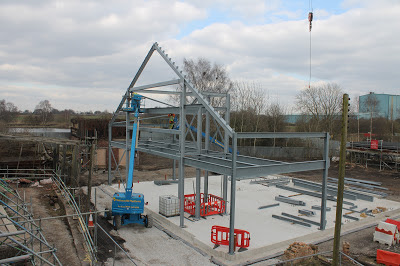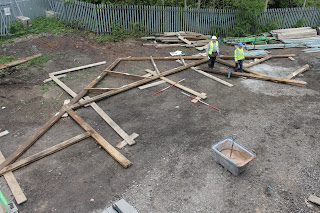The transport to the site went through change over time that
correlated with the wider change in transport.
Canal and River
Much of the 19th-century
open-pan salt works in Northwich developed along the line of the Trent and
Mersey Canal. Initially the Alliance Works and the early Lion Salt Works relied
on the canal network to transport salt along the canal to the Anderton Boat
Lift and down the River Weaver. Photographs show salt being loaded onto canal
barges outside the Lion Salt Works in the late-19th century.
The works had its own fleet of
narrowboats which shuttled back and forth along the Trent and Mersey Canal
between the works and the Anderton Boat Lift carrying 30 ton consignments of
salt to the waiting Weaver Flats and barges. Their names were Duke, Earl,
Ernest, Tempest and Typhoon.
.jpg)
From here it was relayed to
larger barges that ran along the River Weaver. Buried remains of salt chutes
form part of the Scheduled Monument of the Anderton Boat Lift (SM no. 1021152).
These would be used to transport salt directly into the waiting barges below.
The Thompson’s also owned a fleet of Mersey Salt Barges including the Herald of
Peace and Weaver Belle.
The 19th century maps suggest
that coal was delivered to the open pans of the Alliance Works from a private
basin. Likewise coal was delivered directly into the earliest Lion Salt Works
from the canal. Coal could be directly delivered from the canal to Pan House 1.
In addition a tunnel ran from the canal into the centre of the works. The
tunnel allowed coal to be delivered to the series of four fishery pans.
Rail - Salt Trains/ Carriages
The works also relied on the rail
network in parallel with the canal. Salt was transported from the Alliance
Works to the main rail network via a series of tramways. These tramways ran to
the Marston Hall Mine (north-west of the LSW), The Adelaide (Open-Pan) Works (north
of the Trent and Mersey Canal) and The Alliance Works which developed a series
of sidings that ran into the centre of the works. From here the tramway snaked
around and joined sidings in Northwich on the main Chester – Manchester line
(name railway).

After the Alliance Works closed
in c. 1900, new sidings were put in
place that served the Lion Salt Works. They ran around the southern boundary of
the site and finished in front of Pan House 3 and 4. The sidings were not
designed for trains to use but were instead designed for salt wagons that were
brought up to the works by a series of winches from the mineral railway that
served the Marston Mine. The wagons used to wait in a sidings at the bottom end
of Cross Street (the house today is called The Sidings).
A single windlass is still visible in the Pump House. This was powered
by the steam engine in the pump house and drew the wagons up the gradual
incline from the end of Cross Street. A series of pulleys and couplings are
likely to have allowed the carriages to negotiate the twisting route of the
siding.
The Wagons
Two types of wagons operated at the works.
.jpg)
- Open roofed coal wagons. See picture. These brought coal
directly to the barricades of the pan houses where it was unloaded ready
for use in the stoves.
- Covered salt wagons. The salt wagons were covered in order to
protect the salt from rain. The pitched-roofed variety dates to the 1900s.
Later salt wagons after the 1940s had roofs that were barrelled.

The salt wagon now located at the site is not original to
the works but was brought to the site by the Lion Salt Works Trust in the 1990s.
The van was probably built in
Wakefield in c. 1900 by Charles Roberts and Co. The remains of painted
lettering on the side of the van show that it was originally part of a fleet
owned by Chance and Hunt Ltd of Oldbury, Wednesbury and Stafford. The company
was absorbed by Brunner Mond and Co Ltd in 1917 before being taken over by ICI
Ltd in 1927. The remains of ICI lettering are still visible overwriting the
original lettering. Previous surveys (1991) have noted that it is possible to
see the words [repairs advise] and [Winsford].

At the end of its working life it remained at
ICI sidings in Northwich until 1977. It then passed into the hands of the
Conway and Llanrwst Railway Society, North Wales. In 1987 members of the
Foxfield Light Railway helped transfer the van from Dyserth Quarry to
Blaenau-Ffestiniog, where it formed part of a private collection belonging to
Mr R Morris. The wagon was brought to the Lion Salt Works in September 1991 and
has remained on the private railway sidings since.
Road – The Loading Bay
During the final years salt was taken directly from the works
to the docks at Liverpool using road transport. Vans would back up to loading
bay beside Stove House 4. Salt would be packed directly from Stove House 4, the
Packing Area and Stove House 2 into the vans. This was how the Lagos Salt was
exported.
 The remainder of Pan House 3 wall that had been
dismantled was rebuilt and steel lintels put above the existing doorways.
The remainder of Pan House 3 wall that had been
dismantled was rebuilt and steel lintels put above the existing doorways. The ground floor of Stove House 2, was entirely redesigned
in the late-1960s. This involved the insertion of an automated salt scraping
and drying mechanism. Although not unique, (systems like this were built in
Winsford), it was highly unusual as salt had begun to be made by the Vacuum
Salt Process (still used today at British Salt, Middlewich).
The ground floor of Stove House 2, was entirely redesigned
in the late-1960s. This involved the insertion of an automated salt scraping
and drying mechanism. Although not unique, (systems like this were built in
Winsford), it was highly unusual as salt had begun to be made by the Vacuum
Salt Process (still used today at British Salt, Middlewich).  Stove House 5 was dismantled in
2009, in order that it could be entirely rebuilt as the new visitor and
conference centre. This adopted the original location and plan but had a new
concrete base (see March Update http://thelionsaltworks.blogspot.co.uk/2013/05/march-2013-foundations-and-wall-repairs.html).
Stove House 5 was dismantled in
2009, in order that it could be entirely rebuilt as the new visitor and
conference centre. This adopted the original location and plan but had a new
concrete base (see March Update http://thelionsaltworks.blogspot.co.uk/2013/05/march-2013-foundations-and-wall-repairs.html). 















.jpg)


.jpg)


.jpg)




























